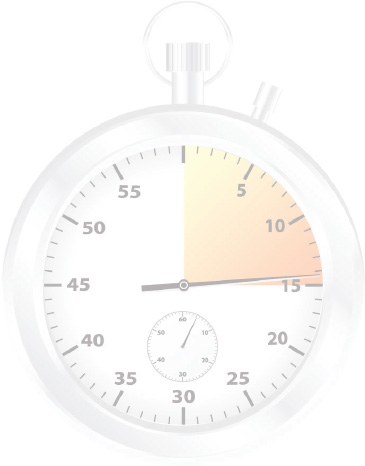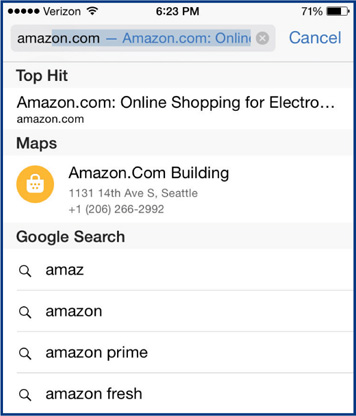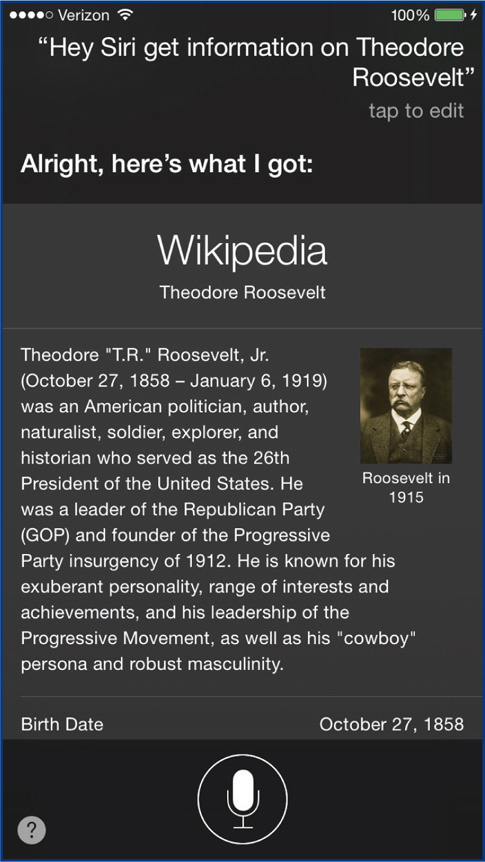Chapter 3
Exploring the Internet
QuickSteps to…
![]() Establish an iPhone Wi-Fi Connection
Establish an iPhone Wi-Fi Connection
![]() Play Internet Audio and Video Files
Play Internet Audio and Video Files
![]() Use Siri to Browse the Internet
Use Siri to Browse the Internet
The Internet provides both worldwide communication and a major means for locating and sharing information. The Internet is at the foundation of the iPhone; the iPhone wouldn’t exist without it because most of what you do with the iPhone is done with the Internet. To use the Internet, you must have a connection to it using either cellular or Wi-Fi. With this connection you can send and receive email; access the World Wide Web; shop; use social networking sites such as Facebook; listen to music; watch movies and TV; and participate in blogs, forums, and newsgroups, among many other things.
In this chapter, we’ll review how to get connected to the Internet, take a good look at Safari and its settings, and then see how you can use Safari to explore the Internet via both navigation and searching. Next, we’ll go over how to use tabs, bookmarks, and history, and then we’ll review how to get and use information on the Internet, including audio and video files. Finally, we’ll cover how to control Internet security.
CONNECT TO THE INTERNET
With a cellular service, you sign up with AT&T, Sprint, T-Mobile, or Verizon (in the United States), start your iPhone, tap the Safari icon, and you are on the Internet. With Wi-Fi, you can use someone else’s connection, such as in a coffee shop, library, hotel, or airport, often for free (we’ll talk about how to connect there in a moment). If you want Wi-Fi in your home or office and don’t already have a connection, you can get one from a local telephone company, a cable TV company, a satellite link, or an independent Internet service provider (ISP). If you already have Wi-Fi available in your home or office and just need to connect your iPhone to it, skip to “Use the World Wide Web” a little later in this chapter.
 Establish an iPhone Wi-Fi Connection
Establish an iPhone Wi-Fi Connection
To use your iPhone in a Wi-Fi area, called a “hotspot,” you must tell the iPhone about it and probably give the iPhone the password for the hotspot. When you first enter a Wi-Fi hotspot that you want to use with your iPhone, after turning on your iPhone, follow these steps:
1. Tap Settings | Wi-Fi and turn Wi-Fi on if it isn’t already. Review the list of Wi-Fi networks that are available at your location.

2. Tap the wireless network you want to use. If there is a lock symbol for this network, indicating that a password is required, a Password dialog box will appear.
3. If needed, enter the network password and tap Join. You will be connected to the Wi-Fi network and, in most cases, to the Internet.
USE THE WORLD WIDE WEB
The World Wide Web (or just the Web) is the sum of all the websites in the world—examples of which are CNN (shown next), Amazon, and the BBC. The World Wide Web is what you can access with a web browser such as Safari.

 Get Familiar with Safari
Get Familiar with Safari
Safari comes standard with the iPhone and provides an excellent means to access the Internet and do anything it is possible to do with a web browser. Several other browsers, including Google Chrome, are available as apps you can download from the App Store, but this book assumes you are using Safari to access the Internet.
Review Safari’s Controls
Start Safari and review its controls (from the iPhone’s Home screen, tap Safari). At the top and bottom of the Safari screen are a series of icons and features that let you control it. From left to right, these are as follows:
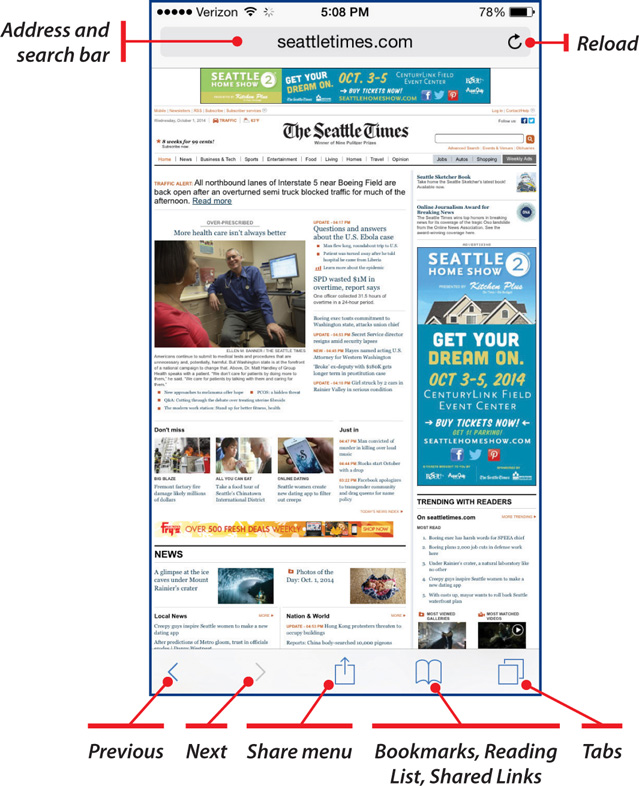
• The address and search bar allows you to type in a web address, or URL, to open the website in Safari. For example, if you wanted to open CNN, you would type cnn.com in the address bar. This same bar also allows you to enter keywords to use in searching the Internet, as you might do directly in Google. As you will see in the next section, you can select the search engine that is used to do the searching for this field. Google is the default, but Yahoo! and Bing are also options in Settings | Safari.
• Reload lets you re-download the selected web page from its server to see any changes in the page, such as late-breaking news or the latest prices on an auction site. If a web page is not behaving the way it should, reloading it can often fix the problem. While a webpage is being loaded, the Reload icon is replaced with a Stop icon (an X) that, if you click it, will stop the loading of the web page.
• Previous and Next let you return to the pages you have visited previous to or following the present page.
• The Share menu allows you to tap various actions you can take to share the current website address, including AirDrop to a nearby iPhone, iPad, or iPod; text messaging or emailing it to a friend; putting it on Twitter or Facebook; adding it to your Home screen; printing or copying it; and adding it to either your Bookmarks or Reading List.

• Bookmarks, Reading List, and Shared Links opens a set of three lists: one for the bookmarks (website pages) that you tap to keep, one for web pages with articles you want to come back and read, and one for web pages that have been shared with you.
• Tabs identify separate website pages you have opened; simply tap a tab to see its page.
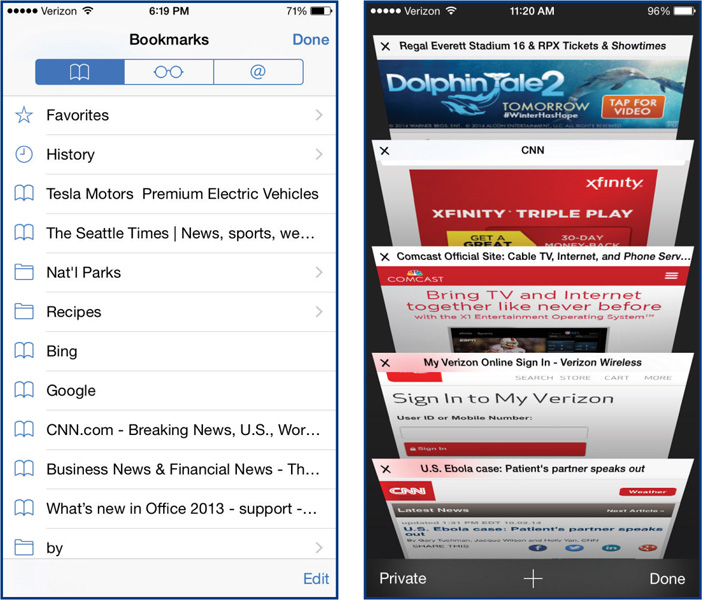
![]()
TIP When you see a web address such as http://www.amazon.com, all you have to type is amazon.com (the “http://www.” is assumed). If you have been to the site recently, you only have to type enough of the name for it to be unique; as you see in the illustration, typing amaz got me Amazon.com.
Look at Safari’s Settings
In iPhone’s Settings, there is a full set of settings for Safari. From the Home screen, tap Settings | Safari.
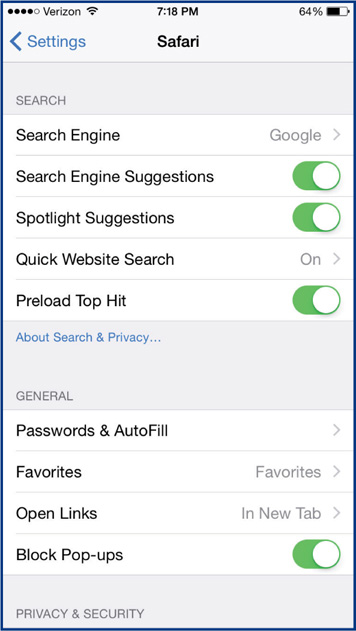
Safari’s settings include the following:
• Search Engine allows you to choose the search engine used: Google (the default), Yahoo!, or Bing.
• Search Engine Suggestions allows you to turn off search engine suggestions and only display the most likely result of the search.
• Spotlight Suggestions allows Safari to use your Spotlight search history, including the suggestions you selected to determine the top suggestions in the current search.
• Quick Website Search allows you to search within a website by including the website address in the search. For example, entering Amazon Quicksteps displays suggestions of QuickSteps books on Amazon.
• Preload Top Hit allows Safari to immediately start loading what it determines is the most likely search result page based on your bookmarks and browsing history.
• Passwords & AutoFill allows you to turn on or off the automatic filling out of web forms with your contact information, including names, passwords, and other information that you have previously given to a website. This is turned off by default, and it is a good idea to leave it that way. Although it is a handy feature, it can lead to giving out information when you don’t want to do so.
• Favorites allows you to establish the defaults that are suggested when you enter an address or search term.
• Open Links allows you to control whether clicking a link or opening a new page replaces the current page in the current tab or opens a new tab displaying the new page.
• Block Pop-ups allows you to prevent a website from opening a second little window for whatever purpose. Here again, history has colored the prevailing view of pop-ups. They can be a pain if they are giving you information you don’t want, but if they open a web form you need to fill out, they can be useful. The default is On, blocking pop-ups. Depending on what you are doing, you might want to turn this off.
• Do Not Track allows you to turn on or off the prevention (if it is on) of collecting information, such as websites you visit and your name, address, and other information you have entered into web forms. With Do Not Track on, AutoFill does not collect information and it doesn’t fill in forms. Also, the history of the websites you have visited is not maintained.
• Block Cookies allows you to choose whether you want to accept cookies that are stored on your iPhone: either always, never, or only from sites you visit. (Cookies are small snippets of information that identify you to the website based on information you gave them.)
• Fraudulent Website Warning tells the iPhone to warn you when you are visiting a website that is not what it seems to be and is suspected of phishing. Phishing sites masquerade as a real site, such as your bank, and fraudulently ask you to enter your personal information, such as username and password. If you get such a warning, you want to immediately leave the site and not enter any information.
• Clear History and Website Data allow you to remove the information on your iPhone from or about the websites you have visited.
• Use Cellular Data tells the iPhone that it can use your cellular network to save Reading List information to iCloud for offline reading.
• Advanced provides three more options:
• Website Data show you which websites are storing how much information on your iPhone.
• JavaScript allows you to turn off accepting programs or apps that use JavaScript, a programming language. Generally, you want to leave JavaScript turned on. Many apps legitimately use it, and if you want to use the app, you have to accept the use of JavaScript. Historically, bad things were done with JavaScript, and, of course, they still can be. However, if you are running apps from the App Store, they are reasonably safe. Apple has vetted these apps.
• Web Inspector allows you to open Safari on your computer, connect the computer to your iPhone with a cable, and look at what a website is doing on the iPhone using Safari’s Advanced Preferences option on your computer. The Web Inspector option is for use by app developers to debug (remove problems from) their apps.
 Browse the Internet
Browse the Internet
Browsing the Internet refers to using a browser, such as Safari, to go from one website to another. You can browse to a site by directly entering a site address, navigating to a site from another site, or using the browser controls. First, of course, you have to open the browser.
Enter a Site Directly
To go directly to a site, follow these steps:
1. Open Safari, tap in the address bar, and tap the X on the right of the bar to erase the current contents.
2. Begin typing the address of the site you want to open. The iPhone will give you suggestions and fill in the address bar. I got these after typing gopro and needed to only tap the first suggestion to go to the site. I could also have typed gopro.com and tapped Go to open that web page.
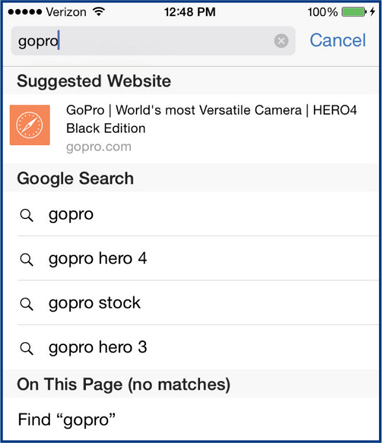
![]()
TIP The onscreen keyboards that appear when the address bar is tapped change the label of the RETURN key to GO.
Use Site Navigation
Site navigation uses a combination of links and menus on one web page to locate and open another web page, either in the same site or in another site.
• Links are words, phrases, sentences, or graphics that, when tapped, take you to another location. They are often a different color, banded (as “Learn More”; see the following left image), or underlined.
• Menus contain one or a few words in a horizontal list (as in “Standard Surf Music”; see the following right image) or vertical list (or both) that, when tapped, take you to another location.
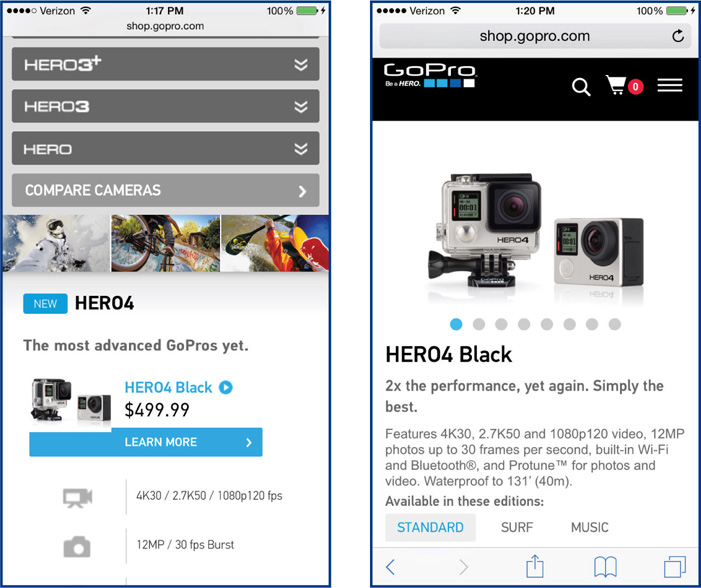
If you hold your finger on a link or a menu option, which is really a link within a menu, a pop-up menu will be displayed, allowing you to open the link in the same tab, open it in a new tab, add it to your Reading List, or copy it, allowing you to paste it in an email, text message, or elsewhere.

Use Browser Navigation
Browser navigation uses the controls on your browser at the top and bottom of Safari, as described in “Review Safari’s Controls,” earlier in this chapter, to go to another location.
 Search the Internet
Search the Internet
You can search the Internet in two ways: by using the search facility built into Safari and by using an independent search facility on the Web.
Search from Safari
Tap in the address/search box at the top of the Safari screen, tap one of the popular sites or a site you have visited, or begin to type a site name to search for sites you have recently visited or search for sites that contain keywords. For example, type veal. The search engine—Google is the default—will display several suggested web pages while you are typing, as well as whether there are any matches on the current web page. You can tap any of the suggestions to open those pages.
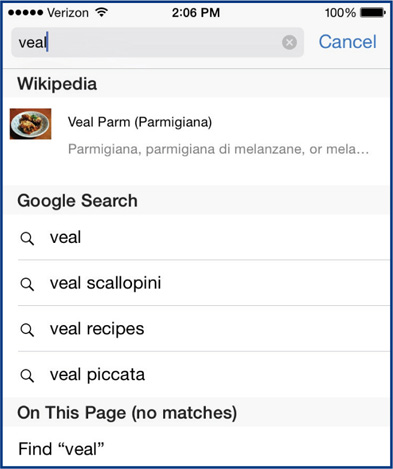
Search from an Internet Site
There are several directly accessed Internet search sites. Among these are Google, Bing, and Yahoo! Because Google is the default, you can open Google by simply tapping Go on the keyboard to display its search results. For example, with the word “veal” as entered in the previous section, you would get these results:

![]()
TIP When you enter search criteria, place quotation marks around certain keywords or phrases to get only results that match those words exactly.
 Save a Bookmark
Save a Bookmark
Sometimes, you visit a site that you would like to return to quickly or often. Safari has the ability to save sites as bookmarks for easy retrieval.
Add a Bookmark
To save a site to the Bookmarks list, follow these steps:
1. Open the web page you want to add to your Bookmarks list, and make sure its correct address (URL) is in the address bar.
2. Tap the Share menu icon in the bottom center and then tap Add Bookmark. The Add Bookmark dialog box will open (see the following left image).
3. Adjust the name as needed in the text box (you may want to type a new name you will readily associate with the site).
4. Initially, the Location option is “Favorites,” meaning that the link will be saved to the Favorites bar. If you tap that option, though, you can choose to save the link to the Bookmarks list or to a subfolder you have within Bookmarks (see the following right image).
5. Choose where you want to save the link and tap Save.

Save to the Home Screen
You can choose to have a link to a website added to the Home screen as you would an app. Here’s how:
1. Open the web page you want to add to your Home screen, and make sure its correct address (URL) is in the address bar.
2. Tap the Share menu icon and tap Add To Home Screen. The Add To Home dialog box will open.
3. Adjust the name as needed in the text box and tap Add. You’ll see the icon for the page appear on the Home screen.
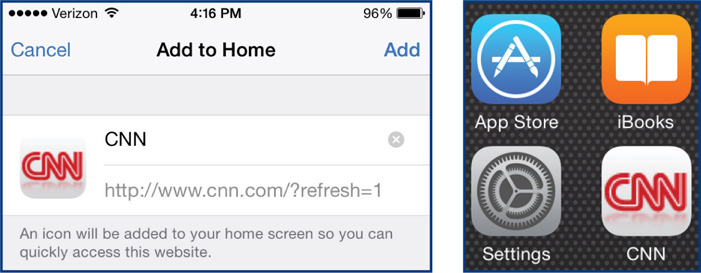
 Organize Bookmarks
Organize Bookmarks
Safari provides two places to store your bookmarks: a Bookmarks list and a Favorites list.
![]()
TIP The web pages you have pinned to the Home screen from Safari can also be organized in any way you want.
Rearrange, Edit, and Delete Bookmarks
The items on your Bookmarks list are displayed in the order you added them, with the name you left them with, but you can move them to a new location, edit their names, and delete them. Follow these steps:
1. In Safari, tap the Bookmarks Reading List Shared Links icon and then, if needed, tap the Bookmarks segment on the left. Tap Edit on the bottom right. The Bookmarks editing features are displayed.

2. Locate the site you want to reposition. Touch and hold the three bars (grip strip) on the right of the bookmark, and drag it up or down to where you want it.
3. To edit a bookmark’s name, tap the right arrow on the mid-right of the bookmark to open the Edit Bookmark dialog box.
4. In the top text box, edit the name as you would edit other text on the iPhone (see Chapter 2).
5. In the bottom text box opposite Location, tap the greater-than sign and tap where you want to store the bookmark (see the following section).
6. To delete a bookmark, tap the delete icon on the left of it and then tap Delete. When you are done editing bookmarks, tap Done.

Create New Folders
You can add your own folders within Bookmarks:
1. In Safari, tap the Bookmarks Reading List Shared Links icon and then, if needed, tap the Bookmarks icon and tap Edit on the bottom right. The Bookmarks editing features are displayed, as you saw earlier.
2. Tap New Folder in the lower left, type the name for the folder, tap where you want to store the folder, and tap DONE on the keyboard.
3. Use the steps in the “Rearrange, Edit, and Delete Bookmarks” section earlier to move the desired bookmarks to the new folder.
Put Bookmarks in Folders
You can put a site in either your own folders (see “Create New Folders”) or the default Bookmarks list and Favorites bar, which operate like folders. Here’s how:
1. Open the web page you want in your Bookmarks list, and make sure its correct address, or URL, is in the address bar.
2. Tap the Share menu icon, tap Add Bookmark, adjust the name as needed in the text box, tap Location, tap the folder to use, and tap Save.

USE INTERNET INFORMATION
Of course, the reason for accessing the Internet is to use the information you find there—to read it, save it, play its media, or send it to a friend.
 Work with a Web Page
Work with a Web Page
An iPhone screen displaying a web page in Safari works just like any other iPhone screen and gives you the same tools you’ve used elsewhere on the iPhone. In Safari, you can perform the following tasks:
• Select pages, links, items, and options by tapping them.
• Move a page being displayed up or down, left or right, by dragging it with your finger.
• Change a page by swiping from right to left or bottom to top.
• Enlarge a page by spreading two fingers apart.
• Reduce a page by pinching two fingers together.
• Enlarge just an article if it is in a separate frame by double-tapping the article.
• Scroll just an article if it is in a separate frame by dragging with two fingers.
• See a link’s destination by touching and holding the link, which also allows you to open the link in a new tab and add it to the Reading List.
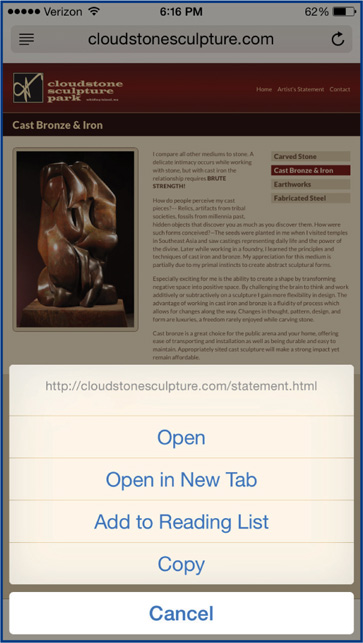
• Fill out a form by tapping the first field, typing what is requested, and then tapping Next or Previous.
• Return to a web page you have viewed by tapping the Tab icon in the lower right and tapping the page you want to return to. On the Tab list screen you can go to a new page by tapping the plus sign in the bottom center (see earlier illustration).
 Read Web Pages
Read Web Pages
Safari has a reader with which you can separate out an article from advertisements and make reading an excellent experience.
1. Navigate in Safari to an article you want to read and then tap it. On the left end of the address bar you should see the Reader icon (a stack of lines).
2. Tap the Reader icon. The article will appear, filling the screen.
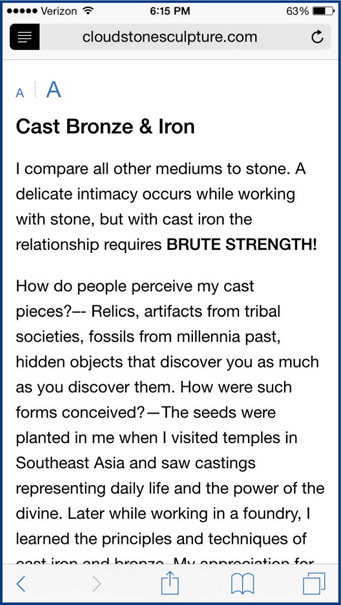
3. Scroll by swiping up (from bottom to top) as you would any other page.
4. To close the Reader, tap the Reader icon again in the address bar.
![]()
NOTE The Reader provides a good way to forward an article because it removes the ads and transfers just the article. Use the Share menu to do this, which works with the Reader as well.
 Play Internet Audio and Video Files
Play Internet Audio and Video Files
You can play audio and some video files on the Internet with Safari directly from a link on a web page. The exception is that the iPhone cannot play video files that use the Adobe Flash technology (several apps are available in the App Store, such as the Rover browser, that will allow you to play Flash content). Many web pages have links to audio and video files, such as the one shown next. To play these files, simply tap the play button in the center. The player will open to play the requested piece.

![]()
TIP To search for information within an open web page in Safari, type the keywords you want to search for in the Search field in the upper-right area, and then tap the entry or entries under On This Page.
 Control Internet Security
Control Internet Security
As you read earlier in this chapter, Safari Settings allow you to control several aspects of Internet security. You can determine how you want to handle cookies placed on your computer by websites and use Do Not Track to prevent the website from bothering you in the future, among several other settings. These controls are found in Settings.

Handle Cookies
Cookies are small pieces of data that websites store on your computer so that they can remind themselves of who you are. These can save you from having to constantly enter your name and ID. Cookies can also be dangerous, however, letting people into your iPhone where they can potentially do damage. Safari lets you determine when you will block cookies:
1. In the Home screen, tap Settings | Safari.
2. In Safari Settings, tap Block Cookies.
3. Consider the four choices you have:

• Always Block means that every time you visit a site, you must sign in, and there is no memory of your last visit that might take you back to what you were doing the last time you were on the site.
• Allow From Current Website Only is a onetime exception for the current website.
• Allow From Websites I Visit means that you will allow cookies from the specific website you visit but block cookies from third parties and advertisers.
• Always Allow means that any site you come across can add whatever information they want.
The default, and my recommendation, is Allow From Websites I Visit. In my mind, cookies can be more of a benefit than a problem. You can see who has stored information on your iPhone by tapping Advanced at the bottom of Safari Settings and then tapping Website Data, as discussed earlier in this chapter.
Use Do Not Track
Safari’s Do Not Track option in Safari Settings gives you a way to visit a website and not leave any information on both your iPhone and the visited website that you had visited it. This allows you to take a peek at a website and not leave any trace so as to more safely browse and view websites. While you have Do Not Track turned on, your browsing history, temporary Internet files, and cookies are not stored on your iPhone, preventing anyone looking at your phone from seeing where you have browsed. In addition, a request is passed on to the Internet content provider (the site you visit) not to track your visit. It is up to the site to honor that request or not!
![]()
NOTE If you are using your iPhone in a school or business that has security controls, they may be able to see where you have browsed, even with Do Not Track, and it is not perfect at preventing a website from knowing who you are.
Turn On Private Browsing
Private Browsing, which is turned on at the bottom of the Tabs screen, is another aspect of Do Not Track. If you tap Private on the Tabs screen, your screen will darken, Safari will not remember the sites you visit, they will not be stored on the Tabs screen, and cookies and other information will not be stored on your phone. Also, the sites will be requested not to track you.
Enable Fraudulent Website Warning
Fraudulent sites are websites that present themselves as legitimate ones—including banks, brokerages, email services, and others—when in fact they are not and only want to get information from you, such as your user ID, password, Social Security number, and other information. This is called phishing. If Fraudulent Website Warning is enabled, Safari will warn you when it thinks a site you are visiting is suspected of phishing. This is enabled by default, and I strongly recommend that you leave it that way. Safari’s ability to do this is less than perfect, so you need to be aware of this practice and watch out for it.
GATHER INFORMATION AND SHOP ON THE INTERNET
The World Wide Web is a phenomenal source of information and place to shop. It is the world’s largest library, museum, and shopping mall rolled into one—you only need to use it, which you can do with your iPhone and Safari.
 Search for Information
Search for Information
We have discussed using Safari to browse and search the Internet, but not where that takes you and what to do when you get there. There are, of course, millions of subjects you could search on, but let’s look at two examples: researching a historical figure (Theodore Roosevelt) and gathering demographic information (the population growth in the 10 largest U.S. cities).
Research Theodore Roosevelt
In Safari, simply typing theod provides several places to start. The first, Wikipedia, is a huge online encyclopedia maintained by everybody who wants to contribute to it. The second is the official White House presidential bio. The third is a general search on the name. Tapping the Wikipedia entry provides a wealth of information that you can read and use as needed. Tapping the general search provides numerous other sites and resources.
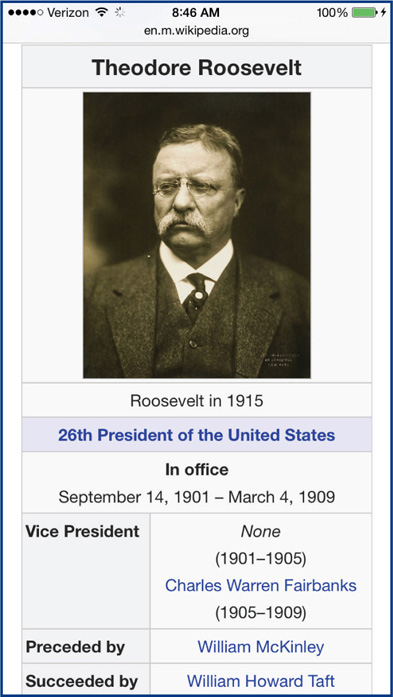
Gather Demographic Information
Here, to get what we want I had to fully type growth of ten largest us cities, but I got numerous sites to explore and many related searches. You have to look at several to get the information you want.

 Shop on the Internet
Shop on the Internet
As with sources of information, there are innumerable places to buy goods and services on the Internet; you only need to search for them. Two examples are a small black leather purse and French restaurants in Seattle.
Look for a Black Purse
My wife wanted a classic small black leather purse and hadn’t seen one lately in stores, so she turned to the Internet. Typing small black leather purse produced a number of firms offering that product. Selecting any one or more of those sites offered many items to select from.

Find a French Restaurant
If you live in or near a large city, you know that restaurants come and go fairly quickly, so if you like a particular type of food, Internet searching can be helpful. Here is a search for French restaurants in Seattle.

Tapping on most of them opens a map and reviews, and further tapping opens a website for the restaurant with menus, photos, and reservations.
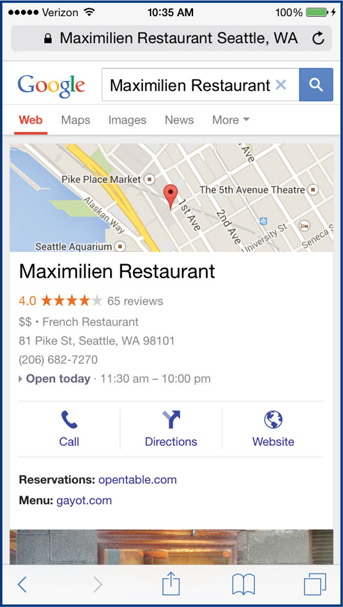
 Use Siri to Browse the Internet
Use Siri to Browse the Internet
Many times you can use Siri to do the searching for you. For example, you can say, “Hey Siri, get information on Theodore Roosevelt” or “find French restaurants in Seattle.” Siri does an excellent job getting information on “T.R.” and providing a list of French restaurants. In the latter case, Siri goes on automatically to display the first restaurant listed and offers to make reservations for you.
